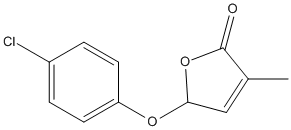4-Cl-Debranone
General
Type : Strigolactone,Debranone,Strigolactone receptors ligand
Chemical_Nomenclature : 2-(4-chlorophenoxy)-4-methyl-2H-furan-5-one
Canonical SMILES : CC1=CC(OC1=O)OC2=CC=C(C=C2)Cl
InChI : InChI=1S\/C11H9ClO3\/c1-7-6-10(15-11(7)13)14-9-4-2-8(12)3-5-9\/h2-6,10H,1H3
InChIKey : KADGZWRLAWGNRI-UHFFFAOYSA-N
Other name(s) : 5-(4-Chlorophenoxy)-3-methylfuran-2(5H)-one,CPMF,4-Cl debranone,SCHEMBL15171485
MW : 224.64
Formula : C11H9ClO3
CAS_number : 1332863-92-9
PubChem : 89737643
UniChem : KADGZWRLAWGNRI-UHFFFAOYSA-N
IUPHAR :
Wikipedia :

Target
Families : 4-Cl-Debranone ligand of proteins in family: RsbQ-like
Stucture :
Protein : arath-KAI2.D14L
References (2)
| Title : Rationally Designed Strigolactone Analogs as Antagonists of the D14 Receptor - Takeuchi_2018_Plant.Cell.Physiol_59_1545 |
| Author(s) : Takeuchi J , Jiang K , Hirabayashi K , Imamura Y , Wu Y , Xu Y , Miyakawa T , Nakamura H , Tanokura M , Asami T |
| Ref : Plant Cell Physiol , 59 :1545 , 2018 |
| Abstract : Takeuchi_2018_Plant.Cell.Physiol_59_1545 |
| ESTHER : Takeuchi_2018_Plant.Cell.Physiol_59_1545 |
| PubMedSearch : Takeuchi_2018_Plant.Cell.Physiol_59_1545 |
| PubMedID: 29727000 |
| Gene_locus related to this paper: arath-AtD14 , arath-KAI2.D14L |
| Title : New branching inhibitors and their potential as strigolactone mimics in rice - Fukui_2011_Bioorg.Med.Chem.Lett_21_4905 |
| Author(s) : Fukui K , Ito S , Ueno K , Yamaguchi S , Kyozuka J , Asami T |
| Ref : Bioorganic & Medicinal Chemistry Lett , 21 :4905 , 2011 |
| Abstract : Fukui_2011_Bioorg.Med.Chem.Lett_21_4905 |
| ESTHER : Fukui_2011_Bioorg.Med.Chem.Lett_21_4905 |
| PubMedSearch : Fukui_2011_Bioorg.Med.Chem.Lett_21_4905 |
| PubMedID: 21741836 |